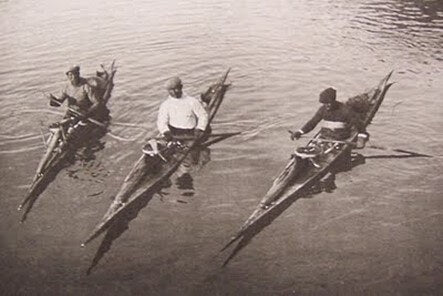The kayak has a rich and ancient history that stretches back around 4000 years to the common understanding. Archaeological evidence suggests 2000 years of history, but indigenous oral tradition proposes a history dating much farther. The oldest known kayak was a display in the State Museum of Ethnology in Munich, Germany. This kayak was believed to have arrived in Holland in 1577. But the history of the kayak, or the qajaq, reaches much farther than the shores of Holland in 1577.
Kayaks were used for various purposes by Artic Indigenous people living in Northern North America, Greenland, and Siberia. Its main use was for hunting, as a kayak is useful for quietly moving toward aquatic animals on inland lakes, rivers, and arctic coastal waters. The kayak was invented by the Inuit, Aleut, and Yup’ik people. It was constructed by stitching animal hides together (typically seal skin) and stretching it over a wood or whalebone frame. Some versions added inflated animal bladders to provide more buoyancy. The meaning of the word kayak (or qajak) reveals more of its history, as the word is derived from the term meaning “man’s boat” or “hunter’s boat”. The hunter (traditionally a man) built his own kayak, so they were very personalized, built according to the knowledge, skill, and experience passed down through the generations before him through the oral traditions. A kayak double-bladed paddle was used to maneuver the kayak. Additional features of the kayak was a garment called a tuilik that both covered the hunter and stretched over the rim of the kayak coaming to keep in the warmth and seal out the cold water. A kayak was generally built for just one person, though there are versions of the kayak that could accommodate two or more hunters. The largest known Indigenous made kayak is called an Umiak could measure up to 18 meters in length.

Kayak and Umaiak by Gordon Miller
Europeans became aware of kayaks when expeditions were made to explore the arctic region during the 19th century. Polar explorers recognized the usefulness of kayaks for negotiating ice-filled open water and for hauling supplies. Sportsmen from England, Germany, and France adopted the kayak as an option for outdoor recreation and fitness. A contemporary design of the kayak was introduced to Europe in 1845 by Englishman John MacGregor. MacGregor’s design, called a Rob Roy, was a foldable wooden frame covered by a durable fabric. After hundreds of years, being honed into the finely tuned hunting machine that the kayak had become for many cultures, there was suddenly a rapid change and development in the kayaking world.
In 1931 for instance, Adolf Anderle used a kayak to paddle down the Salzachofen Gorge on Austria’s Salzach River. Anderle’s exploit inspired the introduction of the International Scale of River Difficulty, a scale using a “class” (Class 1, Class 2, etc.) system to classify the strength of a river’s rapids.
Jump ahead to 1936 where kayaking became an Olympic sport in the Berlin Summer Games. After appearing on a global scale at the Olympics, kayaking became far more popular in America and women began to get involved in the sport as well. Currently, the Olympic Games includes ten different white-water kayak competitions.

Bellow you can watch an amazing documentary from 1922, called “Nanook of the North”, that documents one year in the life of Nanook, an Eskimo (Inuit), and his family. Describes the trading, hunting, fishing and migrations of a group barely touched by industrial technology. Nanook of the North was widely shown and praised as the first full-length, anthropological documentary in cinematographic history.
CLICK ON THE IMAGE FOR AN AMAZING DOCUMENTARY!
Here you have historical photos showing the beauty of the first kayaks:



Sources:
Stephanie Brown, Ocean River Sports
Dry Creed Lake




